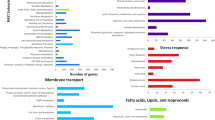Abstract
The denitrifying bacterium Acinetobacter johnsonii strain DBP-3 which was capable of removing phosphate, nitrate, and ammoniacal salt is psychrotolerant, whereas, the cold shock response mechanisms or the cold shock proteins (Csps) was unclear. In this article, the optimal growth temperature (25 °C) and cold shock temperature (7.5 °C) were determined firstly by an Arrhenius plot of the growth of the strain DBP-3. Then, among the seven cold shock-like protein genes which were cloned and identified referenced by A. johnsonii SH046 genome, qRT-PCR and shotgun-LTQ mass spectrometry showed that Csp3 and Csp4 were overexpressed under cold shock condition. Furthermore, Western blotting confirmed the result with the antibodies against Csp3 and Csp4 prepared by ourselves. Finally, the phylogenetic analysis showed that the similarity percent between Csp3 and Csp4 was 76.85 %, and Csp3 and Csp4 belonged to CspE family. The results indicated that CspE is overproduced by temperature downshift and may play an important role in the psychrotolerant process of strain DBP-3.






Similar content being viewed by others
References
Bower CK, Daeschel MA (1999) Resistance responses of microorganisms in food environments. Int J Food Microbiol 50(1/2):33–44
Foght JM, Waterhouse EJ, Aislabie JM, Balks MR (2004) Hydrocarbon spills on Antarctic Soils: effects and Management. Environ Sci Technol 38(5):1265–1274
Gibson TJ (1994) CLUSTAL W: improving the sensitivity of progressive multiple sequence alignment through sequence weighting, positionspecific gap penalties and weight matrix choice. Nucleic Acids Res 22:4673–4680
Graumann P, Marahiel MA (1996) Some like it cold: response of microorganisms to cold shock. Arch Microbiol 166(5):293–300
Graumann P, Marahiel MA (1998) A superfamily of proteins that contain the cold-shock domain. Trends Biochem Sci 23(8):286–290
Graumann P, Wendrich TM, Weber MH, Schröder K, Marahie MA (1997) A family of cold shock proteins in Bacillus subtilis is essential for cellular growth and for efficient protein synthesis at optimal and low temperatures. Mol Microbiol 25(4):741–756
Hall HK, Karem KL, Foster JW (1995) Molecular responses of microbes to environmental pH stress. Adv Microbiol Phys 37:229–264
Jeroen AW, Frank MR, Oscar PK, De Vos Willem M, Abee T (2000) The Role of Cold-Shock Proteins in Low-Temperature Adaptation of Food-Related Bacteria. System Appl Microbiol 23(2):165–173
Jones PG, Inouye M (1996) RbfA, a 30S ribosomal binding factor, is a cold-shock protein whose absence triggers the cold-shock response. Mol Microbiol 21(6):1207–1218
Jones PG, VanBogelen RA, Neidhardt FC (1987) Induction of proteins in response to low temperature in Escherichia coli. J Bacteriol 169:2092–2095
Kandasamy P, Chaturvedi N, Sisodia BS, Shasany AK, Gahio S, Marla SS, Goel R (2013) Expression of CspE by a psychrotrophic bacterium Enterobacter ludwigii PAS1, isolated from Indian Himalayan soil and in silico protein modelling, prediction of conserved residues and active sites. Curr Microbiol 66:507–514
Landsman D (1992) RNP-1, an RNA-binding motif is conserved in the DNA-binding cold shock domain. Nucleic Acids Res 20(11):2861–2864
Lee M, Woo SG, Ten LN (2012) Characterization of novel diesel-degrading strains Acinetobacter haemolysicus MJ01 and Acinetobacter johnsonii MJ4 isolated from oil-contaminated soil. World J Microbiol Biotechnol 28:2057–2067
Li MT, Liu JH, Zhao SJ, Wang ZX, Hao LL (2013) The characteristics of nitrate removal by the psychrotolerant denitrifying bacterium Acinetobacter johnsonii DBP-3, isolated from a low-temperature eutrophic body of water. J Environ Sci Heal B 48:885–892
Livak KJ, Schmittgen TD (2001) Analysis of relative gene expression data using real-time quantitative PCR and the 2−ΔΔCT method. Methods 25(4):402–408
Mohr PW, Krawiec S (1980) Temperature characteristics and Arrhenius plots for nominal psychrophiles, mesophiles and thermophiles. J Gen Microbiol 121(2):311–317
Morita RY (1975) Psychrophilic Bacteria. Bacteriol Rev 39(2):144–167
Peleg AY, de Breij A, Adams MD, Cerqueira GM, Mocali S, Galardini M, Nibbering PH, Earl AM, Ward DV, Paterson DL, Seifert H, Dijkshoorn L (2012) The success of Acinetobacter species; genetic, metabolic and virulence attributes. PLoS ONE 7(10):e46984
Perl D, Welker C, Schindler T, Schröder K, Marahiel MA, Jaenicke R, Schmid FX (1998) Conservation of rapid two-state folding in mesophilic, thermophilic and hyperthermophilic cold shock proteins. Nat Struct Biol 5(3):229–235
Ray B (1986) Impact of bacterial injury and repair in food microbiology: its past, present and future. J Food Prot 49:651–655
Russell NJ, Evans RI, ter Steeg PF, Hellemons J, Verheul A, Abee T (1995) Membranes as a target for stress adaption. Int J Food Microbiol 28:255–261
Song WZ, Lin XZ, Huang XH (2012) Characterization and expression analysis of three cold shock protein (CSP) genes under different stress conditions in the Antarctic bacterium Psychrobacter sp. G Polar Biol 35(10):1515–1524
Tamura K, Stecher G, Peterson D, Filipski A, Kumar S (2013) MEGA6: molecular Evolutionary Genetics Analysis version 6.0. Mol Biol Evol 30(12):2725–2729
Vaitukaitis JL (1981) Production of antisera with small doses of immunogen: multiple intradermal injections. Methods Enzymol 73:46–52
Wynn-Williams DD (1990) Ecological aspects of Antarctic microbiology. Adv Microbial Ecol 11:71–146
Yamanaka K, Fang L, Inouye M (1998) The CspA family in Escherichia coli: multiple gene duplication for stress adaptation. Mol Microbiol 27:247–255
Yao S, Ni J, Ma T, Li C (2013) Heterotrophic nitrification and aerobic denitrification at low temperature by a newly isolated bacterium, Acinetobacter sp. HA2. Bioresour Technol 139:80–86
Acknowledgments
This work was supported by the National Natural Science Foundation of China (51109089) and the Basic Scientific Research Fund of Jilin University (201003061).
Author information
Authors and Affiliations
Corresponding authors
Ethics declarations
Conflict of interest
The authors declare that they have no competing interests.
Additional information
Dan Su and Linlin Hao contributed equally to this work.
Electronic supplementary material
Below is the link to the electronic supplementary material.
Rights and permissions
About this article
Cite this article
Su, D., Hao, L., Chen, F. et al. CspE is Overproduced by Temperature Downshift in the Acinetobacter johnsonii DBP-3. Curr Microbiol 72, 563–569 (2016). https://doi.org/10.1007/s00284-015-0979-3
Received:
Accepted:
Published:
Issue Date:
DOI: https://doi.org/10.1007/s00284-015-0979-3




